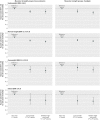Muscular strength in male adolescents and premature death: cohort study of one million participants
- PMID: 23169869
- PMCID: PMC3502746
- DOI: 10.1136/bmj.e7279
Muscular strength in male adolescents and premature death: cohort study of one million participants
Abstract
Objectives: To explore the extent to which muscular strength in adolescence is associated with all cause and cause specific premature mortality (<55 years).
Design: Prospective cohort study.
Setting: Sweden.
Participants: 1,142,599 Swedish male adolescents aged 16-19 years were followed over a period of 24 years.
Main outcome measures: Baseline examinations included knee extension, handgrip, and elbow flexion strength tests, as well as measures of diastolic and systolic blood pressure and body mass index. Cox regression was used to estimate hazard ratios for mortality according to muscular strength categories (tenths).
Results: During a median follow-up period of 24 years, 26,145 participants died. Suicide was a more frequent cause of death in young adulthood (22.3%) than was cardiovascular diseases (7.8%) or cancer (14.9%). High muscular strength in adolescence, as assessed by knee extension and handgrip tests, was associated with a 20-35% lower risk of premature mortality due to any cause or cardiovascular disease, independently of body mass index or blood pressure; no association was observed with mortality due to cancer. Stronger adolescents had a 20-30% lower risk of death from suicide and were 15-65% less likely to have any psychiatric diagnosis (such as schizophrenia and mood disorders). Adolescents in the lowest tenth of muscular strength showed by far the highest risk of mortality for different causes. All cause mortality rates (per 100,000 person years) ranged between 122.3 and 86.9 for the weakest and strongest adolescents; corresponding figures were 9.5 and 5.6 for mortality due to cardiovascular diseases and 24.6 and 16.9 for mortality due to suicide.
Conclusions: Low muscular strength in adolescents is an emerging risk factor for major causes of death in young adulthood, such as suicide and cardiovascular diseases. The effect size observed for all cause mortality was equivalent to that for well established risk factors such as elevated body mass index or blood pressure.
Conflict of interest statement
Competing interests: All authors have completed the ICMJE uniform disclosure form at
Figures






Comment in
-
Muscle strength during adolescence is associated with longevity.Evid Based Med. 2013 Oct;18(5):e48. doi: 10.1136/eb-2012-101195. Epub 2013 Mar 2. Evid Based Med. 2013. PMID: 23455007 No abstract available.
References
-
- Kodama S, Saito K, Tanaka S, Maki M, Yachi Y, Asumi M, et al. Cardiorespiratory fitness as a quantitative predictor of all-cause mortality and cardiovascular events in healthy men and women: a meta-analysis. JAMA 2009;301:2024-35. - PubMed
-
- Myers J, Prakash M, Froelicher V, Do D, Partington S, Atwood JE. Exercise capacity and mortality among men referred for exercise testing. N Engl J Med 2002;346:793-801. - PubMed
-
- Ortega FB, Ruiz JR, Castillo MJ, Moreno LA, González-Gross M, Warnberg J, et al. [Low level of physical fitness in Spanish adolescents: relevance for future cardiovascular health (AVENA study)] [Spanish]. Rev Esp Cardiol 2005;58:898-909. - PubMed
-
- Al Snih S, Markides KS, Ray L, Ostir GV, Goodwin JS. Handgrip strength and mortality in older Mexican Americans. J Am Geriatr Soc 2002;50:1250-6. - PubMed
-
- Fujita Y, Nakamura Y, Hiraoka J, Kobayashi K, Sakata K, Nagai M, et al. Physical-strength tests and mortality among visitors to health-promotion centers in Japan. J Clin Epidemiol 1995;48:1349-59. - PubMed
Publication types
MeSH terms
LinkOut - more resources
Full Text Sources
Other Literature Sources
